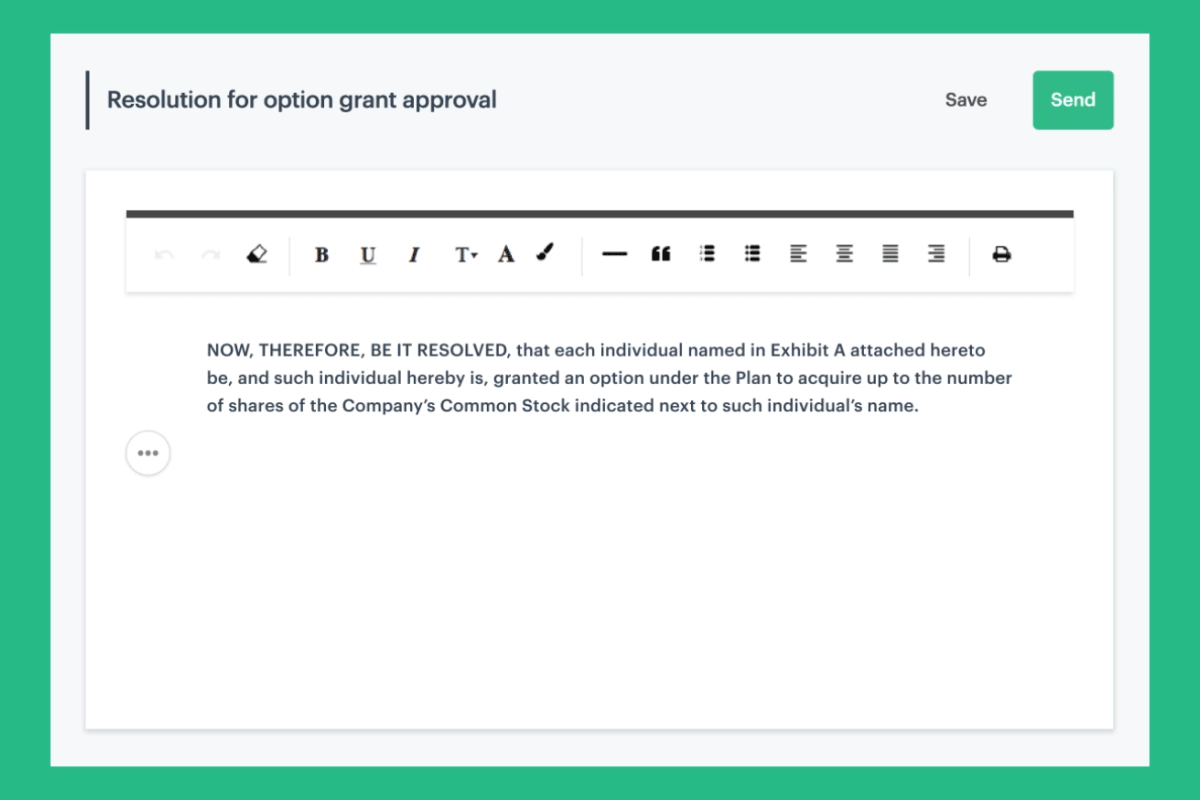
In 2019, we rebuilt Carta’s Board Consents product, and many companies on Carta now use this functionality to formally approve the company’s usage of Carta and to issue new option grants on Carta.
Below, we detail why we’ve been investing in this functionality and why we are enabling this enhanced board experience for all U.S. companies in 2020 such that all of their future option grants can be drafted, approved, and distributed within Carta.
Greater efficiency
Approving and issuing new options using Carta’s Board Consents product is far more efficient than any other method.
Outside of Carta, issuing new options generally involves multiple formats and tools, mail merges, and manual quality checks (see Appendix, below). This results in duplicated effort, data transcription errors, and version control issues, as well as unnecessary clean-up work.
With Carta, the entire process of issuing options—everything from collaborating on grants and drafting board consents, to obtaining approval and distributing option agreements—is done on one platform, and the company’s cap table updates automatically. With just one data set and one system, there’s no need for mail merges and wasted effort.
Improve corporate governance and data integrity
Issuing options via Carta’s Board Consents product is more defensible from an audit perspective, provides greater data integrity, and ensures the securities actually approved by the board of directors match those that are issued. Historically, what’s sent to the board could vary from what’s reflected in the minute book, which could vary from the actual grant agreements sent out. This is solved by orienting the process around one centralized source of truth.
Traditional (verbal) approvals conducted in live board meetings are even more problematic from a data integrity perspective, as the minutes to record corporate actions are often created from memory, notes scribbled in the moment, or looking back on slides discussed in the room. Options approved in live meetings are new securities created out of thin air (i.e. they exist the moment they are approved), but the records to support them are often created weeks after the fact.
Enable the future of private liquidity
Finally, some have asked why Carta is doing more to facilitate corporate governance. The reality is that the issuance of private securities is invariably tied to the corresponding board action, and it’s beneficial to link securities with the corporate actions by which they were approved.
Looking further out, Carta is building the future of private liquidity in Carta Liquidity, and providing greater liquidity for security holders requires closely coupling rights, restrictions, and other governance data with the securities themselves. Tracking corporate actions separately from the securities they impact adds unnecessary friction and prevents deep linking between the two, which impedes efficient mechanisms for liquidity. To give founders and employees more opportunities to benefit from the equity they hold, we need to modernize the infrastructure by which their equity is granted.
By creating and tracking board actions on Carta, our clients and law firm partners are benefiting from unprecedented efficiency and data integrity, enhancing corporate governance, and helping to lay the foundation for a new era of accelerated private liquidity. We invite you to utilize Carta’s Board Consents product as you collaborate with your board in 2020.
If you have any questions or feedback about our Board tools, please contact us at boardfeedback@carta.com.
DISCLOSURES: This communication is on behalf of eShares Inc. d/b/a Carta, Inc. (“Carta”). This communication is not to be construed as legal, financial or tax advice and is for informational purposes only. This communication is not intended as a recommendation, offer or solicitation for the purchase or sale of any security. Carta does not assume any liability for reliance on the information provided herein.
Carta Capital Markets LLC (“CCMX”) | CCMX is currently seeking regulatory approval to operate a FINRA-registered broker-dealer and Alternative Trading System (ATS), which will be designed to facilitate the trading of the unregistered equity securities of private non-reporting issuers | All descriptions of future product and service offerings are subject to receiving all requisite regulatory approvals | CCMX undertakes no obligation to update content herein | No business, investment, tax or legal advice is provided by CCMX | Potential investors are advised to conduct their own due diligence and consult with their tax, legal, and financial advisors with respect to any investment | All securities involve risk and may result in partial or total loss.
Appendix
The legal workflow for issuing options (kicking off 2020, no less) often looks something like the following:
1. A list of pending options is compiled by the client and sent to outside counsel (e.g. email, Excel spreadsheet, Word doc, PowerPoint slide). 2. The list of options is then formatted into a new table (listing grant type, state of residence, etc.).2. That new table is dropped into a draft written consent.3. That formal written consent is finalized and loaded into an e-mail or e-signature tool, and then circulated to board members.4. All board members then sign/approve.5. The option grant table is pulled out (yet again) and used for a mail merge with the company’s form option agreements (or, each individual option agreement is drafted by hand using copies of the form).6. Each newly compiled option agreement is checked by counsel to ensure it matches the written consent.7. Each individual option agreement is then uploaded into an e-signature tool (or printed out) and circulated for acceptance by its respective grantee.8. All grantees need to sign/accept.